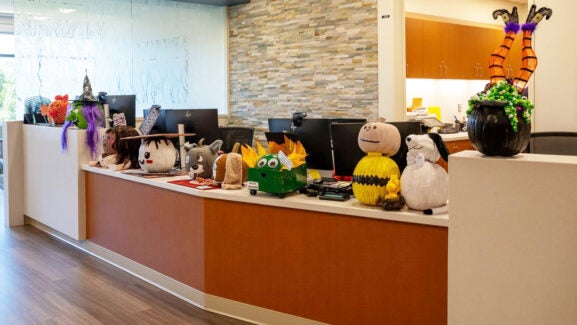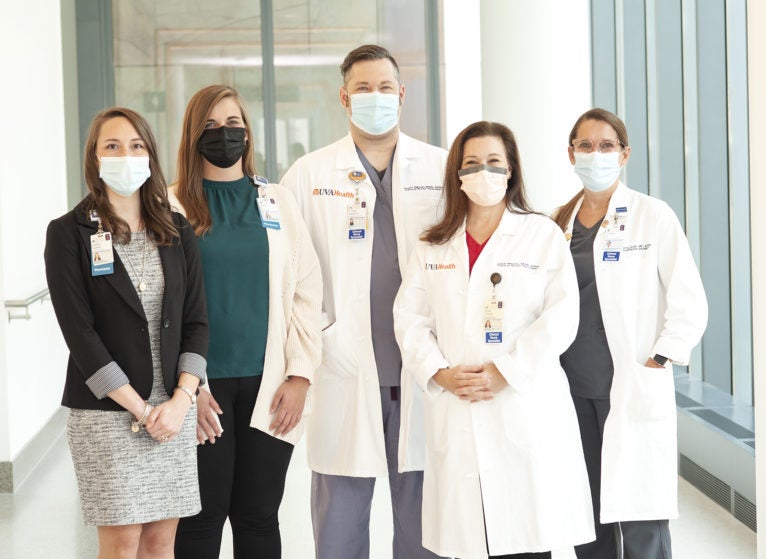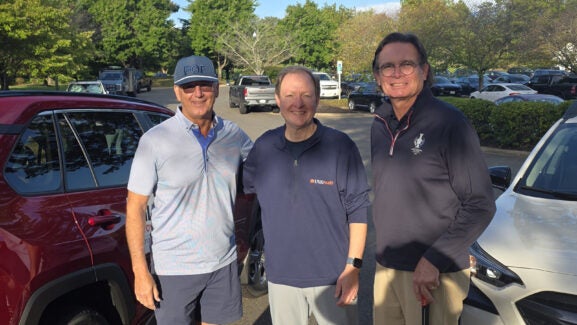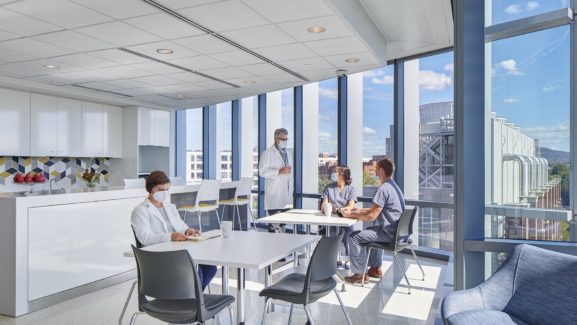

Nurses now spend less time away from the bedside, thanks to a pilot medication-delivery collaboration between Pharmacy leaders Matthew Jenkins (not pictured), (l-r) Katelyn Hipwell, and Bailey Eason, and Clinical Nurse Specialists Scott Darrah, Kristi Kimpel-Wilkins, and Kim Elgin.
Reducing Trips to the Pharmacy: Major Win for Frontline Staff and Patients
The hours and days after someone has surgery or suffers traumatic injuries are the most critical time. The nurses and other hospital staff who care for these patients, understandably, want to be close to the bedside. But an important part of care — giving powerful pain-relieving drugs — can take nurses away from the hospital unit.
It is not unusual for a nurse to need to take several trips during a single shift to our central pharmacy to obtain controlled substances such as morphine or fentanyl.
Last December, during rounds with Wendy Horton, CEO, UVA Medical Center, and Reid Adams, MD, Chief Medical Officer, and a team of clinical nurse specialists, bedside staff asked an important question: Was it possible to make controlled substances more readily available on the units?
The answer was yes. But it wasn’t something that could happen overnight. It took a group of about 15 people, who’ve spent several months gathering data, then launching and assessing several pilot projects. They faced several hurdles and couldn’t solve every issue. But the end result has been a success and is starting to be rolled out across the hospital.
This pharmacy initiative came at a particularly important time, as UVA Health, along with hospitals nationwide, are facing bedside staffing shortages.
“Nurses are short staffed, which is why this is coming to a peak. They shared with us that ‘Going to the inpatient pharmacy takes us away from the unit when we’re already short. So how can you help?’” says pharmacist Bailey Eason. (She, along with colleagues Katelyn Hipwell and Matthew Jenkins, helped oversee the pharmacy side of the project.)
Eason adds, “Our response was, ‘We want to help. But we don’t want to burn out our pharmacy technicians as we’re short staffed too.’ So we had to find that right balance and, of course, safety is something that we can never compromise on.”
Finding & Eliminating Wasteful Hot Spots
The pharmacy project is part of a larger waste-reduction initiative being led by Kim Elgin, DNP, CNS-BC, and our 14 other Clinical Nurse Specialist (CNS) team members.
At UVA Health, CNSs serve an interesting and growing advanced practice nursing role, Elgin says. They not only provide care for specialty patient populations, but they are looking at multiple areas where they can partner with leaders to reduce waste and frustrations for frontline staff, while increasing efficiency. They are serving as clinical consultants for five areas, which include Pharmacy, equipment, supplies, IT, and Nutrition Services. Read about how replacing 617 barcode readers has saved countless hours for front-line staff.
Elgin says, “It was during peak pandemic time and nursing teams were really struggling with being stretched. So we began to have conversations in a couple of units. We discussed while we can’t control staffing, what would help increase efficiency and workflow?”
When feedback from the frontline staff reached Pharmacy, a team there jumped at the possibility of bringing meaningful change to make it easier for nurses to keep their patients as comfortable as possible.
“For so long, COVID was crippling us,” says Hipwell from Pharmacy. “We were coming out of the COVID thaw, and everybody was rediscovering where we were. It was re-energizing to have other stakeholders and partners engaged now and ready to improve our processes,” she adds.
Assessing Time Spent Away from Patients
Last winter, the Pharmacy project team assessed how much time nurses were spending on trips to the inpatient pharmacy. A typical trip involves an elevator ride, a 5-minute walk to the pharmacy, and a wait at the medication pickup window. “We estimated 10- to 15-minute average time spent picking up medication,” Eason says. That adds up to a lot of time on one unit, for example, where in one month, 227 trips were taken for fentanyl infusions.
Waste-Reduction Wins
“Our underlying philosophy of the pharmacy is getting the medication as close as possible to our patients,” says Hipwell. “But one of the biggest hurdles is that controlled substances have very specific regulatory requirements, and we need to maintain a very specific chain of custody.”
“Pharmacy is a very complex world,” adds Eason.
For example, medications can be transported through our pneumatic tube system. But controlled substances lock down the entire system. So it isn’t a feasible solution to send controlled substances through the tube system when thousands are needed on a monthly basis.
But there were lots of opportunities for reducing wasted time and resources by fine-tuning our existing medication-delivery systems.
In addition to the central inpatient pharmacy, medications can be kept locked away on the hospital units in one or two Pyxis machines. These are like highly secure and sophisticated vending machines where drugs can be dispensed and closely tracked. Pharmacy technicians keep the Pyxis machines stocked.
The team began testing changes last April with pilot projects on three units: STICU, (surgical trauma intensive care unit, SIMU (surgical intermediate care unit), and 3 West acute care.
“Through the pilots, we’ve been evaluating needs and challenges we didn’t anticipate so we’ll be ready to execute for all inpatient care units in the coming months,” Jenkins says.
Micromanaging to Test Best Practices
With one pilot, pharmacy operations team rearranged medications in the Pyxis stations to make room for controlled substance infusions to be delivered by pharmacy and stored securely.
“We started with one or two drugs at a time,” Hipwell says. “We asked questions like:
- How do we successfully know what’s our trigger to get it up to the patient?
- How do we utilize our technology to accurately assess when to send restocks based on patient need?
- And if it’s not coming out of a batch process, how do we time it right so we don’t waste it?
“We were micromanaging and putting it on our control-substance technicians to help us evaluate our processes ... We needed to ensure that we could get Pyxis machines loaded up and create a nice secure electronic closed-loop process, which is easy to validate and ensure everything is where it needs to be.”
Last May, the team implemented a change to the distribution of our patient’s own medications (including high-cost patient’s own medications) storing them in Pyxis across all of our inpatient units, rather than in the central pharmacy.
Cost Savings a Bonus
In addition to saving time, the pharmacy project found ways to save money. Typically, it’s more cost effective to make medications on site. But because UVA does not have a large compounding facility, inhouse-made products have a short expiration date and are more likely to get thrown away. “Purchasing three products from a larger facility offered extended dating. So now we can readily stock up in Pyxis and not be worried about the short dating,” says Hipwell.
The pharmacy project could not have been a success without the efforts of many, including managers and assistant managers in Pharmacy, assistant nurse managers and nurse managers on the pilot units, along with frontline unit staff and pharmacy technicians.
“The nurses are great partners,” Hipwell says. “Their feedback has been a main contributor to why we’ve been successful. Everyone has process improvement in mind and are always trying to get better than we were yesterday."
Kicking Off CNS Week
Highlighting projects such as this is perfect timing to kick off National Clinical Nurse Specialist Recognition Week (CNS Week), Sept. 1-7, an annual event that acknowledges the contributions of the nearly 90,000 CNSs in North America. The National Association of Clinical Nurse Specialists (NACNS) established CNS week in 2009 to commemorate and celebrate the birth of Hildegard Peplau, who was born on Sept. 1, 1909. Dr. Peplau was a prominent nursing theorist whose landmark book, Interpersonal Relations in Nursing, emphasized the nurse-client relationship as the foundation for nursing practice and today serves as the basis of the CNS role in healthcare. Thank you to our CNSs for the valuable part they play in healthcare and healthcare delivery.
Latest News



